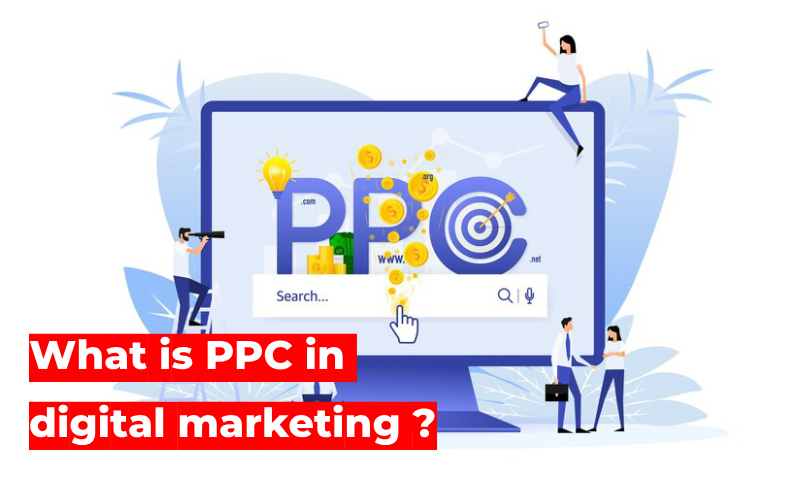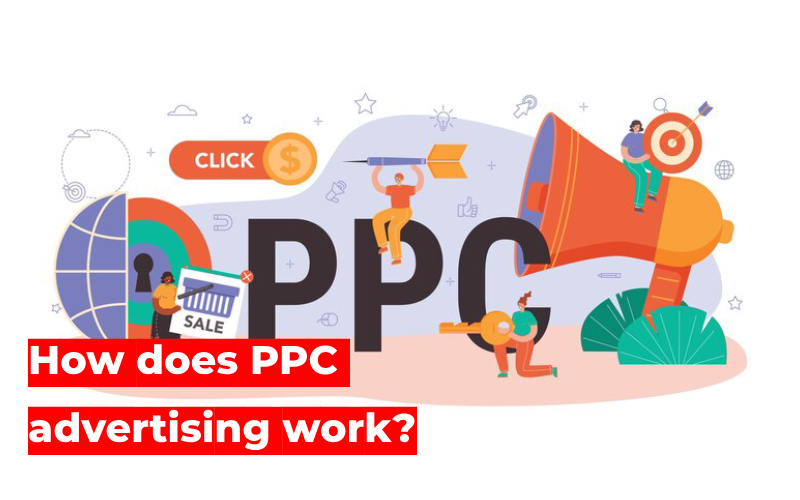Elevate Your Business Affordably with Our Services.
In the pay-per-click (PPC) model of digital marketing, marketers are charged a fee each time their ad is clicked.It’s a way to buy visits to your website rather than attempting to earn those visits organically through techniques like SEO (Search Engine Optimization).. Here’s a breakdown of how PPC in digital marketing:

Ad Campaign Creation: Advertisers create ads, typically text-based, but they can also be in the form of images or videos. These ads are designed to attract the attention of the target audience and encourage them to click.
Keyword Selection: For search engine PPC, advertisers select keywords or key phrases related to their products or services. When users search for these keywords, the ad may appear.
Bidding: Advertisers place bids based on the cost of each click on their ad. This is done in a competitive auction format, and the highest bidder often gets the top ad placement.
Ad Placement: Ads are displayed in the search engine’s results pages or on websites and social media platforms that participate in the ad network.
Clicks and Costs: Advertisers are charged for each click on their ad, hence the name “Pay-Per-Click.” The cost per click (CPC) can vary widely depending on factors like competition for keywords and the quality of the ad.
Budget Management: Advertisers set a daily or monthly budget to control their spending. Once the budget is exhausted, the ads will stop appearing until the budget is replenished.
Ad Performance Monitoring: Advertisers track the performance of their ads using various metrics, such as click-through rate (CTR), conversion rate, and return on investment (ROI).
Ad Optimization: Based on performance data, advertisers can make adjustments to their ad campaigns. This might involve refining keyword selection, improving ad copy, or changing bidding strategies.
Targeting: PPC allows for precise targeting options. Advertisers can target specific demographics, locations, devices, and even the time of day when their ads are shown.
Ad Extensions: Advertisers can enhance their ads with extensions that provide additional information, such as location information, phone numbers, or links to specific pages on their website.
Ad Quality: Search engines and platforms often assess ad quality. Ads that provide relevant and valuable content to users may receive higher placements or lower CPCs.
Your website can generate leads and sales through PPC campaigns. However, it requires ongoing management and optimization to ensure that you’re getting a good return on your advertising investment. Additionally, it’s important to comply with advertising policies and guidelines set by the platform you’re using for PPC to avoid issues with your campaigns.

PPC in digital marketing strategies in advertising is one of the most common forms of online advertising and is often used to drive targeted traffic to websites. It is also an effective way to measure the success of an advertising campaign. It’s a way for businesses to buy visits to their websites rather than relying solely on organic traffic. Advertisers bid on a keyword or phrase, and the highest bidder appears in the sponsored results section of the search engine results page. When a searcher clicks on the ad, the advertiser is charged a fee. The advertiser can then track the success of their campaign by the number of clicks and their return on investment.
Ad Creation: Advertisers create advertisements, which can vary in format. Common types of PPC ads include text ads, display ads, and video ads. These ads are designed to promote a product, service, or offer.
Keyword Selection: For search engine PPC (like Google Ads), advertisers choose relevant keywords or key phrases that are associated with their products or services.
Ad Auction: When someone performs a search on a search engine, a real-time auction takes place to determine which ads will be displayed on the search results page. The auction considers various factors, including the relevance of the keywords, ad quality, and the bid amount.
Bid Management: Advertisers set a maximum bid for each keyword, indicating the highest amount they are willing to pay for a click. Higher bids often result in better ad placement, but other factors also influence ad positioning.
Ad Placement: The search engine or advertising platform determines which ads to display based on the auction results. The ads are shown either at the top or bottom of the search results page or on relevant websites within the advertising network.
Ad Display: When a user’s search query matches the selected keywords, and their demographics or interests align with the target audience, the ad is displayed.
Clicks: If a user clicks on the ad, the advertiser is charged a fee for that click. The cost per click (CPC) varies depending on factors like keyword competitiveness and bid amounts.
Landing Page: The user is directed to a specified landing page on the advertiser’s website after clicking the advertisement. This page is typically designed to convert visitors into customers, whether that means making a purchase, filling out a form, or taking another desired action.
Ad Performance Monitoring: Advertisers closely monitor the performance of their PPC campaigns using various metrics, including click-through rate (CTR), conversion rate, cost per conversion, and return on investment (ROI).
Campaign Optimization: Based on the performance data, advertisers make adjustments to their campaigns to improve results. This can include modifying ad copy, refining keyword lists, adjusting bid amounts, or targeting different demographics.
Budget Management: Advertisers set a daily or monthly budget to control their advertising spend. Once the budget is exhausted, the ads will stop running until the budget is replenished.
Continuous Testing: Successful PPC advertisers often engage in A/B testing, experimenting with different ad creatives, landing page designs, and campaign settings to identify what works best.
PPC advertising offers advertisers a high degree of control and flexibility, as they can target specific audiences, track results in real time, and adjust their campaigns as needed. It’s a competitive environment where effective keyword research, compelling ad copy, and careful budget management are essential for achieving a positive ROI.
The best pay-per-click (PPC) platforms for your advertising campaigns can depend on your specific business goals, target audience, and budget. Different platforms offer unique advantages and reach different audiences. Here are some of the most popular and effective PPC platforms:
Google Ads (formerly Google AdWords): Google Ads is one of the most widely used PPC platforms. It allows you to display ads on Google Search, YouTube, and a vast network of partner websites. Google Ads offers precise targeting options, including keywords, demographics, and geographic location.
Microsoft Advertising (formerly Bing Ads): Microsoft Advertising is similar to Google Ads but focuses on advertising on Microsoft’s search engine, Bing, and its partner network, including Yahoo. It can be particularly effective if your target audience uses Bing as their primary search engine.
Facebook Ads: Facebook’s advertising platform is known for its powerful targeting capabilities. You can create highly specific audience segments based on demographics, interests, behavior, and more. Facebook also owns Instagram, making it a good choice for visual and mobile advertising.
Instagram Ads: Instagram offers its own advertising platform, which is seamlessly integrated with Facebook Ads. It’s especially effective for businesses with visually appealing products or services.
Twitter Ads: Twitter allows you to promote your tweets, accounts, or trends. It’s suitable for real-time marketing and reaching an audience interested in trending topics.
LinkedIn Ads: For B2B advertising, LinkedIn is the preferred platform. This helps you tailor your messages to the right people, increasing your chances of making a connection. Additionally, it can help you save time and money since you won’t be sending messages to people who don’t match your target criteria.
YouTube Ads: Owned by Google, YouTube offers various ad formats, including in-stream ads that appear before or during videos, as well as display ads. It’s ideal for video content and reaching a wide audience.
Pinterest Ads: Pinterest is a visual discovery platform that’s effective for businesses in niches such as fashion, home decor, and food. It offers promoted pins and shopping ads.
Amazon Advertising: If you sell products on Amazon, Amazon Advertising can be highly effective. It allows you to promote your products within Amazon search results and on product pages.
Snapchat Ads: Snapchat is popular among younger demographics. It offers various ad formats, including snap ads, story ads, and augmented reality (AR) lenses.
Quora Ads: Quora is a question-and-answer platform that offers advertising opportunities. It’s suitable for businesses looking to target users seeking answers to specific questions.
When choosing the best PPC platform for your business, consider factors such as your target audience, advertising goals (e.g., brand awareness, lead generation, e-commerce sales), budget, and the type of content you want to promote (text, images, videos). It’s often beneficial to use multiple PPC platforms to reach a broader audience and diversify your online advertising efforts. Additionally, continuously monitor and optimize your campaigns to maximize their effectiveness.
Here is an A-Z list of essential pay-per-click (PPC) terms and their definitions to help you better understand the world of PPC advertising:
An ad group helps to organize and target ads more effectively. Each ad group should have a unique set of keywords and ads to maximize the effectiveness of the campaign. Ad groups can also be used to track the performance of different ads and adjust bids accordingly. Ad groups help organize your campaign and ensure that ads are relevant to the keywords.
Ad Extensions: Additional information and links that can be added to a PPC ad to provide more context and encourage clicks. Extensions for site links, callouts, and locations are a few examples.
Ad Impressions: The number of times an ad is displayed to users, regardless of whether they click on it or not.
Ad Rank: A value used to determine the position of an ad in the search results. Ad Rank is calculated based on the bid, ad quality, and expected click-through rate.
Bid: The highest price an advertiser will accept for a click on their advertisement.. Bids can be set at the keyword level in PPC campaigns.
Click-Through Rate (CTR): The ratio of clicks to ad impressions, expressed as a percentage. CTR is a key metric for measuring ad performance and relevance.
Conversion: An action that a user takes after clicking on an ad, such as making a purchase, filling out a form, or signing up for a newsletter.
Cost Per Click (CPC): Click-through rate (CTR) stands as a pivotal metric in evaluating the effectiveness and pertinence of advertisements. CPC can vary depending on competition and bid amounts.
Daily Budget: The maximum amount an advertiser is willing to spend on their PPC campaign in a single day.
Display Network: A network of websites and apps that display PPC ads. This can include both Google Display Network and other advertising platforms.
Exact Match: A keyword match type in which ads are triggered only when the exact keyword phrase is entered by the user.
Quality Score: A metric used by search engines to measure the relevance and quality of ads, keywords, and landing pages. Elevated Quality Scores have the potential to result in improved ad positioning and reduced Cost Per Click (CPC).
Impression Share: The percentage of ad impressions an advertiser receives compared to the total number of impressions available. It indicates how often your ads are shown for relevant searches.
Keyword Match Types: Different ways to match keywords in PPC campaigns, including Broad Match, Phrase Match, and Exact Match, which determine when an ad is displayed based on variations of the keyword.
Landing Page: The webpage that users are directed to after clicking on an ad. It should be relevant to the ad and designed to encourage conversions.
Negative Keywords: Keywords specified by advertisers to prevent their ads from showing when certain terms are included in a search query.
Quality Score: A metric used by search engines to measure the relevance and quality of ads, keywords, and landing pages. Higher Quality Scores can lead to better ad placements and lower CPC.
ROI (Return on Investment): A measure of the profitability of a PPC campaign, calculated as (Net Profit / Cost of Ads) x 100%. It shows how much revenue is generated for every dollar spent on advertising.
Search Query: The actual terms or phrases users enter into a search engine. Advertisers use search queries to determine which ads to display.
Targeting: The process of specifying the audience demographics, locations, and interests that an advertiser wants to reach with their PPC ads.
URL Parameters: Custom tracking parameters added to destination URLs to monitor the performance of specific ads or keywords.
View-Through Conversion: A conversion that occurs when a user sees but doesn’t click on an ad, but later completes a desired action on the advertiser’s website.
This list provides a good starting point for understanding essential PPC terms, but PPC advertising involves more specialized terminology that may vary depending on the platform and specific strategies used. Continuously educating yourself about PPC terms and practices is important for effective campaign management.
Here’s a step-by-step guide to help you through it:
Building a pay-per-click (PPC) campaign involves several steps to effectively create, manage, and optimize your online advertising efforts. Below, I’ll outline a step-by-step guide to help you set up a successful PPC campaign:
Conduct Keyword Research:
Identify pertinent keywords and phrases that potential customers might use to discover your products or services. Employ keyword research tools like Google Keyword Planner or SEMrush for insights.
Analyze Competitors:
Study your competitors’ PPC strategies to gain insights into their keyword choices, ad content, and overall approach.
Budget Allocation:
Determine your daily, weekly, or monthly budget for your PPC campaign. Start with a reasonable budget aligned with your objectives and adjust it based on performance.
Select the Ideal PPC Platform:
Choose the PPC platform that best matches your goals and target audience. Google Ads and Microsoft Advertising are commonly used for search ads, while social media platforms like Facebook, Instagram, and LinkedIn are suited for display and social advertising.
Organize Your Campaign Structure:
Structure your campaign into ad groups with closely related keywords and ads. This enhances targeting and relevance.
Craft Compelling Ad Copy:
Create engaging and pertinent ad copy for each ad group. Highlight unique selling points, include a clear call to action (CTA), and integrate keywords.
Prepare Landing Pages:
Ensure your landing pages are relevant, user-friendly, and optimized for conversions. Align landing page content with ad copy for a seamless user experience.
Leverage Ad Extensions:
Utilize ad extensions to boost ad visibility and provide additional information to users. Extensions like site links, callouts, and structured snippets enhance ad appeal.
Bid Strategy Selection:
Opt for a bidding strategy that aligns with your campaign objectives. Options include manual bidding, automated bidding, and conversion-based bidding. Regularly monitor and adjust bids to maximize ROI.
Implement Conversion Tracking:
Set up conversion tracking to gauge campaign performance accurately. Track actions like form submissions, purchases, or phone calls to make informed decisions.
Negative Keywords Management:
Employ negative keywords to exclude irrelevant search queries that could trigger your ads. This helps reduce wasted spend and fine-tunes ad targeting.
Enhance Quality Score and Ad Rank:
Focus on boosting Quality Scores by ensuring keyword relevance, high-quality ad content, and a user-friendly landing page experience. Higher Quality Scores can lead to lower costs and improved ad placements.
Monitoring and Reporting:
Regularly review campaign metrics and generate reports to track progress toward your objectives. Use data-driven insights to refine your strategy.
Scaling or Refining:
Based on performance, consider scaling up by increasing your budget or expanding to additional platforms. Alternatively, refine your strategy based on insights gained.
Determine what you want to achieve with your PPC campaign. Is it to drive website traffic, generate leads, increase sales, or raise brand awareness?
Keyword Research:
Identify relevant keywords and phrases that potential customers might use to find your products or services. Use keyword research tools like Google Keyword Planner, SEMrush, or Ahrefs to find relevant keywords and estimate search volumes.
Competitor Analysis:
Analyze your competitors’ PPC strategies. This can provide valuable insights into what keywords they’re targeting, ad copy they’re using, and their overall approach.
Budgeting:
Determine your daily, weekly, or monthly budget for your PPC campaign. Start with a reasonable budget that aligns with your goals and gradually adjust it based on campaign performance.
Select the Right PPC Platform:
Choose the PPC platform that best suits your goals and audience. Google Ads and Microsoft Advertising are popular choices for search advertising, while social media platforms like Facebook, Instagram, and LinkedIn are suitable for display and social advertising.
Create a Campaign Structure:
Organize your campaign into ad groups with closely related keywords and ads. This allows for better targeting and relevance.
Write Compelling Ad Copy:
Craft attention-grabbing and relevant ad copy for each ad group. Highlight unique selling points, include a clear call to action (CTA), and use keywords in your ads.
Set Up Landing Pages:
Ensure that the landing pages you direct users to are relevant, user-friendly, and optimized for conversions. Match the landing page content with your ad copy to provide a consistent user experience.
Ad Extensions:
Extensions like site links, callouts, and structured snippets can make your ads more appealing.
Bid Strategy:
Choose a bidding strategy that aligns with your campaign goals. Options include manual bidding, automated bidding, and conversion-based bidding. Monitor and adjust your bids regularly to maximize ROI.
Conversion Tracking:
Implement conversion tracking to measure the success of your campaign. Track actions such as form submissions, purchases, or phone calls. This data will help you make informed decisions about your campaign.
Launch Your Campaign:
After thoroughly reviewing your settings, launch your PPC campaign. Monitor its performance closely in the initial days to ensure everything is running smoothly.
Optimize and Refine:
Continuously analyze your campaign’s performance. Adjust your keywords, ad copy, and bidding strategies to improve click-through rates (CTR) and conversion rates.
Negative Keywords:
Use negative keywords to exclude irrelevant search queries that could trigger your ads. This helps you reduce wasted spend and improve ad targeting.
Quality Score and Ad Rank Optimization:
Work on improving your Quality Score by ensuring keyword relevance, ad copy quality, and landing page experience.
Monitor and Report:
Regularly review campaign metrics and generate reports to track your campaign’s progress toward your goals.
Scale or Refine:
Depending on your campaign’s performance, consider scaling up by increasing your budget or expanding to additional platforms, or refine your strategy based on what you’ve learned.
Remember that successful PPC campaigns require ongoing monitoring and optimization. Be patient, as it may take time to fine-tune your strategy for the best results. Additionally, stay updated with the latest trends and changes in the PPC landscape to maintain a competitive edge.
Managing your PPC campaigns
Managing your PPC (Pay-Per-Click) campaigns involves a series of ongoing tasks and strategies to optimize performance and achieve your advertising goals. Here’s a brief overview of key aspects of PPC campaign management:
Monitoring and Analysis:
Regularly monitor your campaign’s performance metrics, including CTR, conversion rates, cost per conversion, and ROI. Analyze the data to identify trends and areas for improvement.
Keyword Management:
Continuously review and refine your list of keywords. Add relevant keywords and negative keywords to improve targeting and reduce wasted ad spend.
Ad Copy Optimization:
Test different ad variations to improve ad copy, headlines, and calls to action. A/B testing can help you identify which ad elements perform best.
Bid Management:
Adjust your bids based on performance and budget constraints. Optimize bidding strategies to maximize ROI and maintain competitive ad positions.
Quality Score Improvement:
Focus on improving Quality Scores by ensuring ad relevance, keyword alignment, and user experience on landing pages. Higher Quality Scores can lower costs and improve ad placements.
Ad Extensions and Formats:
Utilize ad extensions to enhance your ad’s visibility and provide more information to users. Experiment with different ad formats, such as responsive search ads or video ads, where applicable.
Landing Page Optimization:
Continuously optimize your landing pages for better user experience and conversions. Ensure that landing pages align with the ad’s message and provide a clear path for users to take the desired action.
Device and Location Targeting:
Analyze device and location performance to allocate budget and adjust bid modifiers accordingly. Focus on areas that generate the most conversions.
Campaign Structure Review:
Periodically review and adjust your campaign structure by creating new ad groups, campaigns, or ad campaigns to maintain relevance and organization.
Ad Scheduling:
Schedule ads to run during peak times when your target audience is most active. Adjust ad scheduling based on performance data.
Competitor Analysis:
Monitor competitors’ ads and strategies. Identify opportunities to differentiate your campaigns and stay competitive.
Budget Management:
Regularly assess your budget allocation across campaigns and adjust as needed. Allocate more budget to high-performing campaigns and keywords.
Conversion Tracking and Goals:
Set up and track conversions to measure campaign success accurately. Adjust your goals and tracking parameters as needed to reflect changes in your business objectives.
Ad Compliance:
Ensure that your ads comply with the platform’s policies and guidelines to avoid disapproval or penalties.
Reporting and Communication:
Create regular reports to communicate campaign performance to stakeholders or clients. Use data-driven insights to make informed decisions.
Stay Informed:
Keep up with industry trends, platform updates, and best practices to adapt your strategies accordingly.
PPC campaign management is an ongoing process that requires constant attention and optimization to maximize the return on your advertising investment. Regularly assessing and refining your campaigns can help you achieve your marketing goals and stay competitive in the online advertising landscape.
PPC digital marketing is a form of online advertising where advertisers pay a fee each time their ad is clicked. It’s used to drive traffic to websites, and advertisers bid on keywords relevant to their target audience.
Some popular PPC advertising platforms include Google Ads (formerly AdWords), Microsoft Advertising (formerly Bing Ads), Facebook Ads, Twitter Ads, and LinkedIn Ads.
PPC advertising can deliver immediate results and targeted traffic to websites. Advertisers have control over their budgets, ad content, and audience targeting.
Quality Score is a metric in Google Ads that assesses the quality and relevance of your ads, keywords, and landing pages. It affects ad placement and the cost per click (CPC). Higher-quality ads often get better ad positions at lower costs.
Regularly monitor and adjust your campaigns. Improve the quality of your ad copy, landing pages, and bidding strategies. Test different ad variations and keywords to improve performance.
Remarketing (or retargeting) is a strategy where you show ads to users who have previously visited your website but did not make a desired action, like a purchase. It aims to re-engage potential customers.
Common mistakes include not doing proper keyword research, not monitoring campaigns regularly, neglecting ad copy and landing page quality, and not targeting the right audience. It’s important to continually optimize and learn from your campaigns.
PPC can benefit a wide range of businesses, but its effectiveness depends on your goals, target audience, and budget. It’s essential to assess whether PPC aligns with your marketing strategy.
Use analytics tools like Google Analytics to track key performance metrics such as click-through rate (CTR), conversion rate, return on investment (ROI), and overall campaign performance. Adjust your strategy based on these insights.
Alfa Tech Industries: Best Digital Marketing Company in Madurai, India & Mujarrah Sharjah, UAE. Expert team, tailored strategies, drive website traffic, generate leads, boost sales.
Explore Call Now Button
Call Now Button

